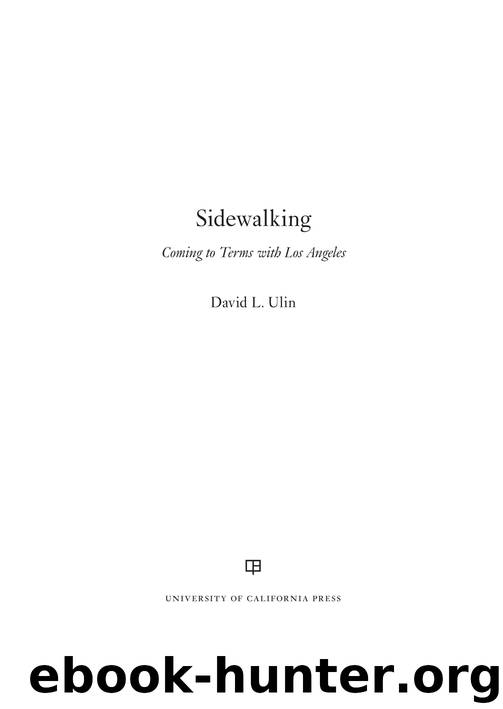Sidewalking by David L. Ulin

Author:David L. Ulin
Language: eng
Format: epub
ISBN: 9780520273726
Publisher: University of California Press
is the ability of the retail band to carry the residential band. Old buildings did it in a very neat way. New buildings are flat, so the developer saves money. He’s got his retail façade and he puts his residential façade on exactly the same plane. What we’re doing in Glendale, we set that back. It’s more expensive to do, but the old buildings always had a difference between where you lived and where you worked. And I thought that was a very important signal people were making at the turn of the century that a home was a home and work was work.
It’s a revealing statement, not least because of the implication (it’s more expensive to do) that some things are more important than money—not at all what you’d expect a mall operator to say. Before we get caught up in the rhetoric, however, we should note that the Americana does not look like Newbury Street, nor does it have any of the older street’s organic urgency. As with many of the streets Caruso lionizes, Newbury grew up as it did for a variety of reasons, including the size and shape of Boston, the availability (or lack thereof) of transportation, and the exigencies of a different world. It has nothing to do with Glendale or Los Angeles, where mixed-use development is a relatively new innovation in a landscape traditionally zoned for single-use. This is the knock (or one of them) on places such as the Grove or the Americana, that what they offer is less a real experience than a broadly imagined facsimile, sanitized and monitored, in which not only architecture but geography, chronology, and, indeed, the very purpose of the street has been corrupted, recalibrated as an expression of our consumerist desires.
What does that mean to the city? For a hint, we need only return to the Hayden Tract. Here, too, we find ourselves in a landscape reconstructed to the specifications of its developers, less organic (let’s say) than contrived. The “gentle repression” of the Hayden Tract is not necessarily economic, and yet, it is without doubt a scripted space. Conversely, the proximity of the Expo Line can’t help but open up the project, making it less the property, or the function, of the entities that created it and more that of everyone. The same is true throughout Southern California, where until recently one had to drive to walk. Melrose Avenue, Venice Beach, Griffith Park, even the Third Street Promenade . . . all are served by lots and parking structures, as is, of course, the Grove. “We’re pulling seventy-eight zip codes to the Grove on a consistent basis,” Caruso acknowledges, even as he avers that “when we build a project, the project is ours. Then, very quickly the project isn’t ours anymore—it starts getting owned by the community. All of a sudden, the surrounding influences change the character and nature of the project and you have to go with what the consumer and the neighborhood is doing with your project.
Download
This site does not store any files on its server. We only index and link to content provided by other sites. Please contact the content providers to delete copyright contents if any and email us, we'll remove relevant links or contents immediately.
Giovanni's Room by James Baldwin(7189)
The Plant Paradox by Dr. Steven R. Gundry M.D(2544)
The Stranger in the Woods by Michael Finkel(2453)
Miami by Joan Didion(2322)
Wild: From Lost to Found on the Pacific Crest Trail by Cheryl Strayed(2210)
INTO THE WILD by Jon Krakauer(2152)
DK Eyewitness Top 10 Travel Guides Orlando by DK(2128)
Trail Magic by Trevelyan Quest Edwards & Hazel Edwards(2125)
Vacationland by John Hodgman(2089)
The Twilight Saga Collection by Stephenie Meyer(2083)
Nomadland by Jessica Bruder(2014)
Birds of the Pacific Northwest by Shewey John; Blount Tim;(1924)
The Last Flight by Julie Clark(1908)
Portland: Including the Coast, Mounts Hood and St. Helens, and the Santiam River by Paul Gerald(1883)
On Trails by Robert Moor(1851)
Deep South by Paul Theroux(1785)
Blue Highways by William Least Heat-Moon(1720)
Trees and Shrubs of the Pacific Northwest by Mark Turner(1680)
1,000 Places to See in the United States and Canada Before You Die (1,000 Places to See in the United States & Canada Before You) by Patricia Schultz(1607)
